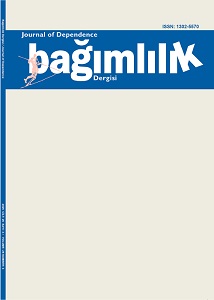EVALUATİON OF RELATİONSHİP ADDİCTON CRİTERİAS WİTH RASCH MODEL
Keywords:
Relationship addiction, item response theory, rasch analysis, DSMAbstract
Objective: In research, according to the DSM-IV diagnostic criteria proposed seven items to evaluate the addiction in partner relations within the scope of the examination of the Item Response Theory is targeted.
Method: The students, studied at all faculties of Ege University, had been randomized according to faculty and class level. 1522 people were reached and 1260 people of them were evaluated in the research. IRTPRO and BILOG-MG programs has been used the analysis of research data.
Results: Participants were 751 women (59.6%) and 509 male (40.4%). According to Rasch model analysis, “spending time to a relationship” of relationship addiction items was marked as Yes the most (66.5%). And then, second item of related to “withdrawal” (47.5%) followed by was observed. It was found to vary Pearson correlation coefficient between .22 and .43, Biserial item correlation coefficient between .30 and .53.
Variance was found .66, standart error was found .71 related to the criterias about relationship addiction. This finding was pointed out that t value of observed differences for the criterias was found less than1.96(p<.05)andforthatreasonitwasnot statistically significant (t1259 = .66/.71 = .93).
Conclusion: It was determined that measuring tool was generally difficult according to rasch model that carried out within the scope of item response theory. It was concluded that show trends of relationship addiction of young adults were low according to item analysis of seven criterias which were recommended to evaluate relationship addiction according to DSM-IV substance dependence criterias.
References
Peele S, Brodsky A. Love and Addiction New York: Taplinger; 1975.
Peele S, Brodsky A. Love Can Be An Addiction, Interpersonal Heroin, Psychology Today, August 1974; 22-26.
Reynaud M, Karila L, Blecha L, Benyami-na A. Is Love Passion an Addictive Disorder?. The American Journal of Drug and Alcohol Abuse 2010; 36: 261-267.
Sussman S. Love Addiction: Definition, Etiology, Treatment, Sexual Addiction, Compulsivity. The Journal of Treatment and Prevention 2010; 17:1: 31-45.
Griffin-Shelley E. Sex and Love: Addiction, Treatment, and Recovery. New York: Praeger Publishing; 1991.
Griffin-Shelley E. Outpatient Treatment of Sex and Love Addiction. New York: Praeger Publishing; 1993.
Fisher HE. Broken Hearts: The Nature and Risks of Romantic Rejection, Romance and Sex in Adolescence and Emerging Adulthood: Risk and Oppurtunities. Booth A. Crouter, AC (editor). London: Lawrence Erlbaum Associates; 2006.
Halpern HM. Sevgi Arsızları. Çelebi AA (Çeviren). İstanbul: Kuraldışı Yayınları; 2001.
Hall J. Surviving Withdrawal: The Break Up Workbook for Love Addicts. E-book; 2010 www.loveaddictionhelp.com
Fisher HE, Brown LL, Aron A, Strong G, Mashek D. Reward, Addiction, and Emotion Regulation Systems Associated with Rejection in Love. Journal of Neurophysiology 2010; 104: 51–60.
Tallis F. Love Sick, Love as Mental Illness. New York: Thunder’s Mouth Press; 2005.
Schaeffer B. Sevgi mi Bağımlılık mı?. Akyüz G (Çeviren). İstanbul: Yakamoz Yayınları; 2011.
Hemfelt R, Minirth F, Meier PD. Love is a Choice: Recovery for Codependent Relationships. Nashville: Nelsonword Publishing; 1989.
Hendrick S, Hendrick C. Liking Romantic Love with Sex: Development of the Perceptions of Love and Sex Scale. Journal of Social and Personal Relationships 2002; 19: 361-378.
Sophia EC, Tavares H, Zilberman ML. Pathological Love: Is It A New Psychiatric Disorder?. Revista Brasiliana de Psiquiatria, 2009; 29(1):55-62.
Lee JA. The Colors of Love: An Exploration of the WaysofLoving.Ontario,Canada:NewPress;1973.
Feeney JA, Noller P. Attachment Style As A Predictor of Adult Romantic Relationships. Journal of Personality and Social Psychology 1990; 58: 281–291.
Lee JA. Love Styles: The Psychology of Love. Sternberg RJ, Barnes ML (Editors). New Haven: Yale University Press; 1988.
Beattie M. İlişkilerde Bağımlılığa Son. Öztürk N (Çeviren). İstanbul: Ganj Yayınları; 2012.
Berks J. Crazy Love. Massey University, Arts in History, 2009; 104-114.
Amerikan Psikiyatri Birliği (1994) Mental Bozuklukların Tanısal ve Sayımsal El Kitabı, Dördüncü Baskı. Köroğlu E (Çeviren Editör). Ankara: Hekimler Yayın Birliği; 1995.
Kline TJB. Psychological Testing: A Practical Approach To Design And Evulation. Thousand Oaks, CA: Sage Publications, 2005.
Elhan AH, Atakurt Y. Ölçeklerin Değerlendirilmesinde Niçin Rasch Analizi Kullanılmalıdır? (Why is it Necessary to Use Rasch Analysis when Evaluating Measures?). Ankara Üniversitesi Tıp Fakültesi Mecmuası 2005; 58: 47-50.
Demars C. Item Response Theory. New York: Oxford University Press; 2010.
Atar B. Tanımlayıcı ve açıklayıcı madde tepki modellerinin TIMSS 2007 Türkiye matematik verisine uyarlanması. Eğitim ve Bilim 2011; 36(159): 255-269.
Tesio L. Measuring behaviours and perceptions: Rasch analysis as a tool for rehabilitation research. Journal of Rehabilitation Medicine 2003; 35(3): 105-115.
DeVellis RF. Ölçek Geliştirme. Kuram ve Uygulamalar. Totan T. (Çeviren Editör) Ankara: Nobel Akademik, 2014.
Downloads
Published
How to Cite
Issue
Section
License
Copyright (c) 2025 Journal of Dependence

This work is licensed under a Creative Commons Attribution-NonCommercial-NoDerivatives 4.0 International License.
...
